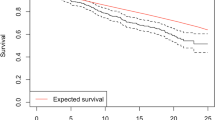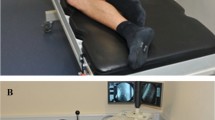Abstract
Study Design
Retrospective cohort study.
Objective
To identify whether an in vivo correlation exists between lumbar spinal subtype (LSS) and lumbar disc degeneration (LDD) in young adults.
Summary of Background Data
Lumbar disc degeneration has largely been ascribed to biomechanical and structural alterations to the disc, which are attributed to aging and pathological physical loading. Sagittal alignment in the asymptomatic spine has also been considered. A biomechanical study by Roussouly and Pinheiro-Franco proposed level-specific patterns in LDD. To date, no in vivo correlation between the LSS and LDD has been established.
Methods
The authors screened 608 consecutive patients over 5.3 years. Lumbar spinal subtype and pelvic parameters were collected from standing lumbar radiographs and were categorized using the classification of Roussouly and Pinheiro-Franco. Lumbar disc degeneration at all lumbar intervertebral levels was classified using criteria of Pfirrmann et al. A stratified disc degeneration score was derived for each patient. Lumbar disc degeneration in type I, II, and IV LSS was compared using chi-square test. Pelvic incidence was correlated with stratified disc degeneration score using Spearman R, to determine whether a high PI was protective against LDD. Statistical significance was accepted at p <.05.
Results
A total of 139 patients were included, with 91 females and a mean age of 32.6 years (range, 13-49 years). For LSS grades I to IV, there were 10 (7.3%), 43 (30.9%), 50 (35.9%), and 36 (25.9%) patients, respectively. The proportion of high-grade (Pfirrmann grades IV and V) LDD increased distally toward the lower intervertebral levels, affecting 2.88%, 2.9%, 5%, 9.4%, 33.1%, and 54% of discs at each sequential lumbar level from T12—L1 to L5—S1, respectively. Age but not gender was statistically significant for higher-grade LDD (p <.0001 and p =.442, respectively). Pelvic incidence across all LSS grades was not significantly correlated with stratified disc degeneration score (Spearman R = 0.0933; p =.335). No LSS (type I-IV) reached statistical significance for a specific pattern of LDD.
Conclusions
In this study, LSS was not statistically significantly correlated with LDD, nor was a high pelvic incidence protective against LDD.
Similar content being viewed by others
References
West W, West KP, Younger EN, Cornwall D. Degenerative disc disease of the lumbar spine on MRI. West Indian Med J 2010;59:192–5.
Cheung KM, Karppinen J, Chan D, et al. Prevalence and pattern of lumbar magnetic resonance imaging changes in a population study of one thousand forty-three individuals. Spine (Phila Pa 1976) 2009;34:934–40.
Takatalo J, Karppinen J, Niinim€aki J, et al. Does lumbar disc degeneration on magnetic resonance imaging associate with low back symptom severity in young Finnish adults? Spine (Phila Pa 1976) 2011;36:2180–9.
Hancock M, Maher C, Macaskill P, et al. MRI findings are more common in selected patients with acute low back pain than controls? Eur Spine J 2012;21:240–6.
Chen JY, Ding Y, Lv RY, et al. Correlation between MR imaging and discography with provocative concordant pain in patients with low back pain. Clin J Pain 2011;27:125–30.
Adams MA, Freeman BJ, Morrison HP, et al. Mechanical initiation of intervertebral disc degeneration. Spine (Phila Pa 1976) 2000;25: 1625–36.
Boos N, Weissbach S, Rohrbach H, et al. Classification of age-related changes in lumbar intervertebral discs: 2002 Volvo Award in basic science. Spine (Phila Pa 1976) 2002;27:2631–44.
Nerlich AG, Schleicher ED, Boos N. 1997 Volvo Award winner in basic science studies. Immunohistologic markers for age-related changes of human lumbar intervertebral discs. Spine (Phila Pa 1976) 1997;22:2781–95.
Videman T, Nurminen M. The occurrence of anular tears and their relation to lifetime back pain history: a cadaveric study using barium sulfate discography. Spine (Phila Pa 1976) 2004;29:2668–76.
Chan D, Song Y, Sham P, Cheung KM. Genetics of disc degeneration. Eur Spine J 2006;15(Suppl 3):S317–25.
Cheung KM, Chan D, Karppinen J, et al. Association of the Taq I allele in vitamin D receptor with degenerative disc disease and disc bulge in a Chinese population. Spine (Phila Pa 1976) 2006;31: 1143–8.
Cheung KM, Samartzis D, Karppinen J, et al. Intervertebral disc degeneration: new insights based on “skipped” level disc pathology. Arthritis Rheum 2010;62:2392–400.
Sambrook PN, MacGregor AJ, Spector TD. Genetic influences on cervical and lumbar disc degeneration: a magnetic resonance imaging study in twins. Arthritis Rheum 1999;42:366–72.
Livshits G, Popham M, Malkin I, et al. Lumbar disc degeneration and genetic factors are the main risk factors for low back pain in women: the UK Twin Spine Study. Ann Rheum Dis 2011;70:1740–5.
Song YQ, Ho DW, Karppinen J, et al. Association between promoter-1607 polymorphism of MMP1 and lumbar disc disease in Southern Chinese. BMC Med Genet 2008;9:38.
Song YQ, Cheung KM, Ho DW, et al. Association of the asporin D14 allele with lumbar-disc degeneration in Asians. Am J Hum Genet 2008;82:744–7.
Battie MC, Videman T, Gill K, et al. 1991 Volvo Award in clinical sciences. Smoking and lumbar intervertebral disc degeneration: an MRI study of identical twins. Spine (Phila Pa 1976) 1991;16: 1015–21.
Battie MC, Videman T, Gibbons LE, et al. 1995 Volvo Award in clinical sciences. Determinants of lumbar disc degeneration: a study relating lifetime exposures and magnetic resonance imaging findings in identical twins. Spine (Phila Pa 1976) 1995;20:2601–12.
Hangai M, Kaneoka K, Kuno S, et al. Factors associated with lumbar intervertebral disc degeneration in the elderly. Spine J 2008;8: 732–40.
Al-Saeed O, Al-Jarallah K, Raeess M, et al. Magnetic resonance imaging of the lumbar spine in young arabs with low back pain. Asian Spine J 2012;6:249–56.
Leino-Arjas P, Kaila-Kangas L, Solovieva S, et al. Serum lipids and low back pain: an association? A follow-up study of a working population sample. Spine (Phila Pa 1976) 2006;31:1032–7.
Leino-Arjas P, Solovieva S, Kirjonen J, et al. Cardiovascular risk factors and low-back pain in a long-term follow-up of industrial employees. Scand J Work Environ Health 2006;32:12–9.
Shiri R, Karppinen J, Leino-Arjas P, et al. Cardiovascular and lifestyle risk factors in lumbar radicular pain or clinically defined sciatica: a systematic review. Eur Spine J 2007;16:2043–54.
Turgut AT, Sönmez I, Cakıt BD, et al. Pineal gland calcification, lumbar intervertebral disc degeneration and abdominal aorta calcifying atherosclerosis correlate in low back pain subjects: a cross-sectional observational CT study. Pathophysiology 2008;15:31–9.
Livshits G, Ermakov S, Popham M, et al. Evidence that bone mineral density plays a role in degenerative disc disease: the UK Twin Spine study. Ann Rheum Dis 2010;69:2102–6.
Samartzis D, Karppinen J, Mok F, et al. A population-based study of juvenile disc degeneration and its association with overweight and obesity, low back pain, and diminished functional status. J Bone Joint Surg Am 2011;93:662–70.
Skrzypiec D, Tarala M, Pollintine P, et al. When are intervertebral discs stronger than their adjacent vertebrae? Spine (Phila Pa 1976) 2007;32:2455–61.
Paajanen H, Alanen A, Erkintalo M, et al. Disc degeneration in Scheuermann disease. Skeletal Radiol 1989;18:523–6.
Paajanen H, Erkintalo M, Kuusela T, et al. Magnetic resonance study of disc degeneration in young low-back pain patients. Spine (Phila Pa 1976) 1989;14:982–5.
Erkintalo MO, Salminen JJ, Alanen AM, et al. Development of degenerative changes in the lumbar intervertebral disk: results of a prospective MR imaging study in adolescents with and without low-back pain. Radiology 1995;196:529–33.
Swischuk LE, John SD, Allbery S. Disk degenerative disease in childhood: Scheuermann’s disease, Schmorl’s nodes, and the limbus vertebra: MRI findings in 12 patients. Pediatr Radiol 1998;28:334–8.
Khoury NJ, Hourani MH, Arabi MM, et al. Imaging of back pain in children and adolescents. Curr Probl Diagn Radiol 2006;35:224–44.
Harding IJ, Charosky S, Vialle R, Chopin DH. Lumbar disc degeneration below a long arthrodesis (performed for scoliosis in adults) to L4 or L5. Eur Spine J 2008;17:250–4.
Quattrocchi CC, Alexandre AM, Della Pepa GM, et al. Modic changes: anatomy, pathophysiology and clinical correlation. Acta Neurochir Suppl 2011;108:49–53.
Miyazaki M, Hymanson HJ, Morishita Y, et al. Kinematic analysis of the relationship between sagittal alignment and disc degeneration in the cervical spine. Spine (Phila Pa 1976) 2008;33:E870–6.
Okada E, Matsumoto M, Ichihara D, et al. Does the sagittal alignment of the cervical spine have an impact on disk degeneration? Minimum 10-year follow-up of asymptomatic volunteers. Eur Spine J 2009;18:1644–51.
Siemionow K, An H, Masuda K, et al. The effects of age, sex, ethnicity, and spinal level on the rate of intervertebral disc degeneration: a review of 1712 intervertebral discs. Spine (Phila Pa 1976) 2011;36:1333–9.
Erg€un T, Lakadamyalı H, Sahin MS. The relation between sagittal morphology of the lumbosacral spine and the degree of lumbar inter-vertebral disc degeneration. Acta Orthop Traumatol Turc 2010;44: 293–9.
Roussouly P, Pinheiro-Franco JL. Biomechanical analysis of the spino-pelvic organization and adaptation in pathology. Eur Spine J 2011;20(Suppl 5):609–18.
Roussouly P, Gollogly S, Berthonnaud E, Dimnet J. Classification of the normal variation in the sagittal alignment of the human lumbar spine and pelvis in the standing position. Spine (Phila Pa 1976) 2005;30:346–53.
Pfirrmann CW, Metzdorf A, Zanetti M, et al. Magnetic resonance classification of lumbar intervertebral disc degeneration. Spine (Phila Pa 1976) 2001;26:1873–8.
Yang X, Kong Q, Song Y, et al. The characteristics of spinopelvic sagittal alignment in patients with lumbar disc degenerative diseases. Eur Spine J 2014;23:569–75.
Liu H, Shrivastava SR, Zheng ZM, et al. [Correlation of lumbar disc degeneration and spinal-pelvic sagittal balance]. Zhonghua Yi Xue Za Zhi 2013;93:1123–8.
Strube P, Hoff EK, Perka CF, et al. Influence of the type of the sagittal profile on clinical results of lumbar total disc replacement after a mean follow-up of 39 months. J Spinal Disord Tech 2013 [Epub ahead of print].
Pellet N, Aunoble S, Meyrat R, et al. Sagittal balance parameters influence indications for lumbar disc arthroplasty or ALIF. Eur Spine J 2011;20(Suppl 5):647–62.
Saleem S, Aslam HM, Rehmani MA, et al. Lumbar disc degenerative disease: disc degeneration symptoms and magnetic resonance image findings. Asian Spine J 2013;7:322–34.
Kim SJ, Lee TH, Lim SM. Prevalence of disc degeneration in asymptomatic korean subjects. Part 1: lumbar spine. J Korean Neurosurg Soc 2013;53:31–8.
Battie MC, Videman T, Levalahti E, et al. Genetic and environmental effects on disc degeneration by phenotype and spinal level: a multivariate twin study. Spine (Phila Pa 1976) 2008;33:2801–8.
Author information
Authors and Affiliations
Corresponding author
Additional information
Author disclosures: TPAG (none); MG (none); BR (none); MSAC (none); HIJ (none).
Rights and permissions
About this article
Cite this article
Torrie, P.A.G., McKay, G., Byrne, R. et al. The Influence of Lumbar Spinal Subtype on Lumbar Intervertebral Disc Degeneration in Young and Middle-Aged Adults. Spine Deform 3, 172–179 (2015). https://doi.org/10.1016/j.jspd.2014.08.006
Received:
Revised:
Accepted:
Published:
Issue Date:
DOI: https://doi.org/10.1016/j.jspd.2014.08.006




